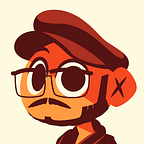How to draw ANYTHING (a quick-start guide) Part 9/10 — Build and use grids
When we start working with 3D volumes, perspective and things rotating on space we’ll likely get somehow lost on the placing of elements over them or in relation to them; for this, we can build and use small grids.
Building a grid is just a matter of tracing light lines over the surface of our shapes to divide it into smaller blocks, making it easier to understand and draw upon it. This will help us see how the surface of something behaves and facilitate the accurate placing of things. Also, if we can visually manipulate the properties of the space we’re drawing on; creating visual distortion effects becomes far easier.
Grids can be applied to anything: from characters to the whole space they interact upon. Tracing spatial grids and establishing vanishing points (where all lines for a particular dimensional axis meet) we get to accurately set a base for perspective drawing.
Grids are a great way to help keep things in place consistency wise, by building a grid we get a referential surface to work upon, helping us place, rotate and distribute elements over our drawing; they’re not always necessary but can always be helpful.
If you have any thoughts, opinions or will like to consult me at something you can DM on twitter at @manuelberbin or email me at hola@manbe.me, if you got here and want to know a little more about me:
My name is Manuel Berbin, you can call me Manbe for short. I specialize in 2d vector cartoon illustration and concept development. I’ve been drawing cartoons my whole life and illustrating professionally at digital media for over 9 years. I was born in Venezuela but I’m currently living in Buenos Aires, Argentina.
If you want to see my 2D illustration work, you can check:
For quick recaps of this articles on presentation formats you can check my Instagram account:
